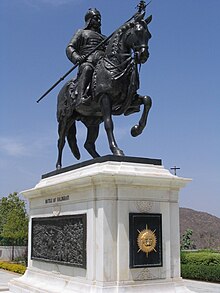Rajputs
The Rajputs or Rajputs (राज्पुत 'sons of the king') were a warlike and knightly tribe from the kshatriya caste , the second of the four Varna caste. In today's India they are an ethnic group in the state of Rajasthan (formerly Rajputana ). In the Middle Ages and the beginning of modern times, the Rajputs made Rajasthan the stronghold of a princely India. Even today they are culturally distinct from all other ethnic groups in the country.
history
The Rajputs are first mentioned in the Mahabharata , with modest territorial possession near Delhi . After a historically dark phase from the 4th to the 8th century AD, the names of the first kings appear as ancestors of 36 Rajput clans. Half indigenous, half descended from invading Scythians and Hephthalites from Central Asia , the Rajputs formed a real military aristocracy based on a feudal social order. The artistic taste of their princes also shaped the medieval temple architecture and sculpture.
The Rajputs were divided into clans with exogamous subgroups and were related to one another through complicated marriage networks. One of their clans, the Tomara, is credited with founding Delhi in 736. The four most famous Rajput clans of the early and high Middle Ages are the Pratihara , Chauhan , Solanki and Paramara .
At the end of the 8th century, the Pratihara dynasty ruled northwestern India, which at that time laid claim to the old capital of Kannauj on the Ganges and also fought against the Arabs in Sindh . The Pratihara state slowly collapsed at the end of the 10th century and the now independent Rajput clans appeared in history under this name.
With the raids and conquests by Mahmud of Ghazni († 1030) and later Muhammad von Ghur († 1206), an external threat arose in addition to the internal disputes of the Rajput clans and other Indian rulers. With their caste-bound fighting style and code of honor, the Rajputs were subject to the massive cavalry attacks of the Islamic conquerors. Indian warfare was the task of certain castes (the Kshatriya) who recruited their followers. Most of these contingents were, however, masses of untrained and barely equipped foot soldiers without internal cohesion, only protected by the (difficult to control) fighting elephants, who could not withstand the (already militarily superior) cavalry of the conquerors. Fayd'herbe de Maudave wrote of them in 1776:
“The Rajputs are the noblest and bravest of the Indians. They fight out of order, but never back down. They are more likely to be killed at the feet of their Raja than to leave the battlefield. "
Under the prince Prithviraj III. Chauhan faced the united Rajput armies in 1191/92 against the Ghurids at Tarain in the Delhi area. The war was finally lost. Prithviraj died and the Muslims conquered all of northern India within a few years. Nevertheless, all Islamic rulers in the Sultanate of Delhi and the Mughal Empire had to defeat the Rajputs (e.g. Chittorgarh in Mewar 1303, 1568) if they wanted to rule the country. Again and again these fights were fought with great cruelty. If a fortress was about to fall, the Rajput wives and concubines burned themselves to death before the men fell in a hopeless battle. After the defeat of the Rajput Confederation under Sangram Singh (von Mewar, † 1528) against the Mughal Mughal Babur († 1530) in the Battle of Khanua (March 1527), the Rajputs never rose to a supraregional power in India. In the second half of the 16th century, Maharana Pratap was at the head of the 36 clan.
The major Rajput principalities were Mewar , Marwar and Amber (later Jaipur ). A mythical family tree or a divine descent served to legitimize the claim to power. The moon and sun were of central importance. The human face in the sun's halo was the coat of arms of Sisodia . In Udaipur and Mewar it can still be found in many palaces and temples today.
In the Mughal Empire ruled Akbar I from 1556 to 1605. After his victory of Chittorgarh (1568) he made the most Rajputenclans his allies by initiated marriages with Rajputenprinzessinnen and sent up into the highest offices of state (ministers, generals, governors) their representatives . In addition, there was his religious tolerance and the abolition of religious taxes, so that he had an effective counterweight to the Muslim nobility. When the strictly religious Muslim Aurangzeb (r. 1658–1707) gave up this policy, he accelerated the decline in power of his dynasty considerably. He tried to split up the principalities and use princes who had converted to Islam as princes, which the Rajputs, however, turned against him.
In the further course of the 18th century the Rajputs lost political weight compared to the Marathas . They have lost their pioneering role against Islam. The removal of Marathic supremacy in British India led to the subordination of their princely states to British suzerainty (as protectorates ). Their independence was retained and only abolished with the formation of modern India (1956). Today the Rajputs no longer have the position they had in earlier centuries.
“All the romantic and magical - the courage, the loyalty, the beauty, the feuds, the poison, the murders, the wars and the worship of women - that in our imagination is linked to the age of knights can be found in the annals of this brave state. "
literature
- Louis Rousselet: L'Inde des Rajahs. Voyage dans l'Inde centrale et dans les présidences de Bombay et du Bengale. Librairie Hachette, Paris 1875, ( digitized version ).
- Hermann Kulke , Dietmar Rothermund : History of India. Kohlhammer, Stuttgart et al. 1982, ISBN 3-17-007097-5 .
Web links
- History and tradition of the Rajput royal family of Mewar ( Memento from April 13, 2009 in the Internet Archive )

